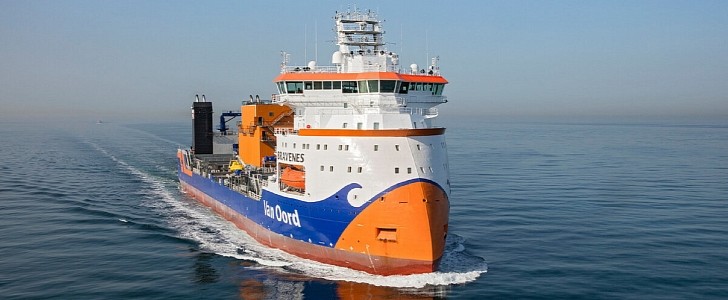American shipbuilder Philly Shipyard was recently awarded around $197 million to build the first Subsea Rock Installation (SRI) vessel for the U.S. market.
With offshore wind having the potential to deliver huge amounts of clean, renewable energy, it is no wonder this is a booming industry. According to the National Renewable Energy Laboratory, as reported by Energy.gov, the United States alone has an offshore wind potential of more than 2,000 gigawatts of capacity (or 7,200 terawatt-hours per year of generation). Now it looks like the country will soon benefit from its first Subsea Rock Installation vessel, which is going to be built by Philly Shipyard.
The ship is going to be Jones Act-compliant (the act requires any vessel carrying cargo between U.S. ports and offshore facilities to be built in the United States) and will measure 461 ft (140.5 m) in length. It will be able to accommodate a crew of 45 and carry up to 20,000 MT of rock.
According to Philly Shipyard, the vessel will be designed by Ulstein, a Norwegian/Dutch company. The ship will be used to transport and deposit the rocks to the ocean bottom, laying a foundation for the monopiles that serve as the prevailing support structure for offshore wind turbines.
The SRI vessel is expected to be delivered in the fourth quarter of 2024. There is also the possibility for a second ship to be ordered, with its delivery being scheduled for 2025. Philly Shipyard won the contract for the vessel from Great Lakes Dredge& Dock Company. If the shipbuilder ends up building the second vessel, too, the total value of the contract would be around $382 million.
Subsea rock installation vessels are commonly used in the offshore industry. In addition to them being used for laying protective coverings of rock around turbine foundations, they are also important for stabilizing structures at the sea bed, such as subsea cables, pipelines, and others.
The ship is going to be Jones Act-compliant (the act requires any vessel carrying cargo between U.S. ports and offshore facilities to be built in the United States) and will measure 461 ft (140.5 m) in length. It will be able to accommodate a crew of 45 and carry up to 20,000 MT of rock.
According to Philly Shipyard, the vessel will be designed by Ulstein, a Norwegian/Dutch company. The ship will be used to transport and deposit the rocks to the ocean bottom, laying a foundation for the monopiles that serve as the prevailing support structure for offshore wind turbines.
The SRI vessel is expected to be delivered in the fourth quarter of 2024. There is also the possibility for a second ship to be ordered, with its delivery being scheduled for 2025. Philly Shipyard won the contract for the vessel from Great Lakes Dredge& Dock Company. If the shipbuilder ends up building the second vessel, too, the total value of the contract would be around $382 million.
Subsea rock installation vessels are commonly used in the offshore industry. In addition to them being used for laying protective coverings of rock around turbine foundations, they are also important for stabilizing structures at the sea bed, such as subsea cables, pipelines, and others.






